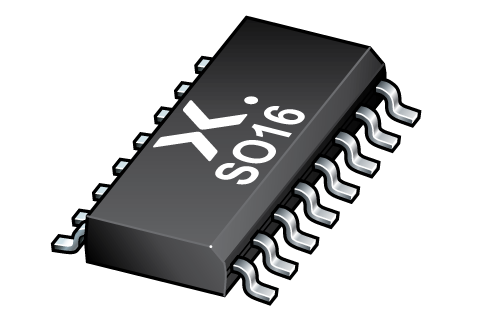可订购部件
| 型号 | 可订购的器件编号 | 订购代码(12NC) | 封装 | 从经销商处购买 |
|---|---|---|---|---|
| HEF4521BT-Q100 | HEF4521BT-Q100J | 935691622118 | SOT109-1 | 订单产品 |

Register once, drag and drop ECAD models into your CAD tool and speed up your design.
Click here for more information24-stage frequency divider and oscillator
The HEF4521B-Q100 consists of a chain of 24 toggle flip-flops with an overriding asynchronous master reset input (MR), and an input circuit that allows three modes of operation. The single inverting stage (A2 to Y2) functions as: a crystal oscillator, an input buffer for an external oscillator or in combination with A1 as an RC oscillator. The crystal oscillator operates in Low-power mode when pins VSS1 and VDD1 are supplied via external resistors.
Each flip-flop divides the frequency of the previous flip-flop by two, consequently the HEF4521B-Q100 counts up to 224 = 16777216. The counting advances on the HIGH-to-LOW transition of the clock (A2). The outputs from each of the last seven stages (218 to 224) are available for additional flexibility.
It operates over a recommended VDD power supply range of 3 V to 15 V referenced to VSS (usually ground). Unused inputs must be connected to VDD, VSS, or another input.
This product has been qualified to the Automotive Electronics Council (AEC) standard Q100 (Grade 3) and is suitable for use in automotive applications.
Automotive product qualification in accordance with AEC-Q100 (Grade 3)
Specified from -40 °C to +85 °C
Wide supply voltage range from 3.0 V to 15.0 V
CMOS low power dissipation
High noise immunity
Low power crystal oscillator operation
Fully static operation
5 V, 10 V, and 15 V parametric ratings
Standardized symmetrical output characteristics
Complies with JEDEC standard JESD 13-B
HBM: ANSI/ESDA/JEDEC JS-001 class 2 exceeds 2000 V
CDM: ANSI/ESDA/JEDEC JS-002 class C3 exceeds 1000 V
| 型号 | VCC (V) | Output drive capability (mA) | Logic switching levels | tpd (ns) | Power dissipation considerations | Tamb (°C) | Rth(j-a) (K/W) | Ψth(j-top) (K/W) | Rth(j-c) (K/W) | Package name |
|---|---|---|---|---|---|---|---|---|---|---|
| HEF4521BT-Q100 | 3.0 - 15 | ± 2.4 | CMOS | 220 | medium | -40~85 | 65 | 1 | 22.8 | SO16 |
| 型号 | 可订购的器件编号,(订购码(12NC)) | 状态 | 标示 | 封装 | 外形图 | 回流焊/波峰焊 | 包装 |
|---|---|---|---|---|---|---|---|
| HEF4521BT-Q100 | HEF4521BT-Q100J (935691622118) |
Active | HEF4521BT |

SO16 (SOT109-1) |
SOT109-1 |
SO-SOJ-REFLOW
SO-SOJ-WAVE WAVE_BG-BD-1 |
SOT109-1_118 |
| 文件名称 | 标题 | 类型 | 日期 |
|---|---|---|---|
| HEF4521B_Q100 | 24-stage frequency divider and oscillator | Data sheet | 2024-08-19 |
| AN90063 | Questions about package outline drawings | Application note | 2025-03-12 |
| SOT109-1 | 3D model for products with SOT109-1 package | Design support | 2020-01-22 |
| Nexperia_package_poster | Nexperia package poster | Leaflet | 2020-05-15 |
| SO16_SOT109-1_mk | plastic, small outline package; 16 leads; 1.27 mm pitch; 9.9 mm x 3.9 mm x 1.35 mm body | Marcom graphics | 2017-01-28 |
| SOT109-1 | plastic, small outline package; 16 leads; 1.27 mm pitch; 9.9 mm x 3.9 mm x 1.75 mm body | Package information | 2023-11-07 |
| SOT109-1_118 | SO16; Reel pack for SMD, 13"; Q1/T1 product orientation | Packing information | 2024-02-19 |
| HEF4521BT-Q100_Nexperia_Product_Reliability | HEF4521BT-Q100 Nexperia Product Reliability | Quality document | 2025-03-20 |
| SO-SOJ-REFLOW | Footprint for reflow soldering | Reflow soldering | 2009-10-08 |
| SO-SOJ-WAVE | Footprint for wave soldering | Wave soldering | 2009-10-08 |
| WAVE_BG-BD-1 | Wave soldering profile | Wave soldering | 2021-09-08 |
The Nexperia Longevity Program is aimed to provide our customers information from time to time about the expected time that our products can be ordered. The NLP is reviewed and updated regularly by our Executive Management Team. View our longevity program here.
| 文件名称 | 标题 | 类型 | 日期 |
|---|---|---|---|
| SOT109-1 | 3D model for products with SOT109-1 package | Design support | 2020-01-22 |
| 型号 | Orderable part number | Ordering code (12NC) | 状态 | 包装 | Packing Quantity | 在线购买 |
|---|---|---|---|---|---|---|
| HEF4521BT-Q100 | HEF4521BT-Q100J | 935691622118 | Active | SOT109-1_118 | 2,500 | 订单产品 |
作为 Nexperia 的客户,您可以通过我们的销售机构订购样品。
如果您没有 Nexperia 的直接账户,我们的全球和地区分销商网络可为您提供 Nexperia 样品支持。查看官方经销商列表。
The interactive datasheets are based on the Nexperia MOSFET precision electrothermal models. With our interactive datasheets you can simply specify your own conditions interactively. Start by changing the values of the conditions. You can do this by using the sliders in the condition fields. By dragging the sliders you will see how the MOSFET will perform at the new conditions set.